Key takeaways:
- Understanding various orthodontic treatment options, including traditional braces and clear aligners, helps in making an informed choice based on aesthetic preferences and lifestyle.
- Establishing a clear timeline for treatment reduces anxiety and encourages commitment, as it helps track progress and reinforces motivation through small achievements.
- Setting specific treatment goals and communicating openly with the orthodontist fosters a supportive environment and enhances engagement in the treatment process.
- Flexibility in adjusting the treatment timeline is vital, as it allows for better management of expectations and accommodates life’s unpredictability without compromising results.
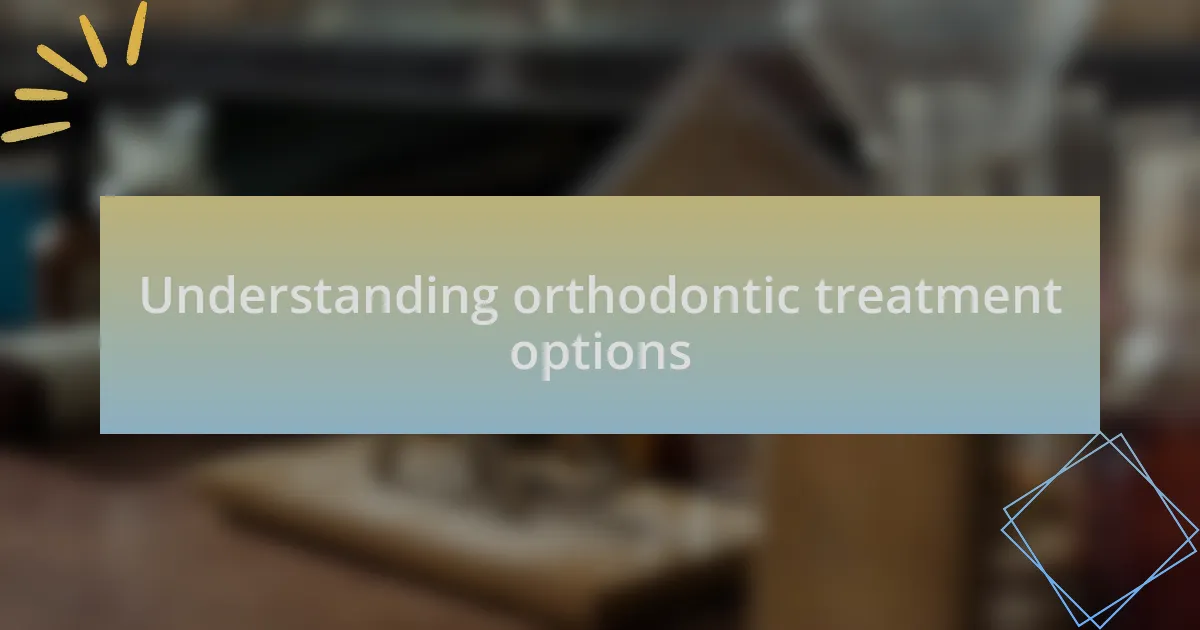
Understanding orthodontic treatment options
When I first began my orthodontic journey, I was surprised by the variety of treatment options available. There are traditional metal braces, which are often the first thing that comes to mind, but I also learned about clear aligners like Invisalign. These options can often provide a more discreet experience, which appealed to me as someone who was self-conscious about my smile.
Thinking about what truly influenced my choice, I remember standing in front of the mirror, envisioning how each treatment could transform my smile. Did I want the classic braces look, or was I looking for something more subtle? For many, the decision comes down to the balance of effectiveness and aesthetics, and I found myself gravitating towards what felt right for me.
Another eye-opening aspect was realizing that each option comes with its own timeline and commitment. For instance, while clear aligners might take longer in some cases, they offer the flexibility of being removed for meals. I often ask myself—how would my day-to-day life shift with each choice? Understanding these nuances not only helped clarify my decision but also made me feel more in control of my journey.
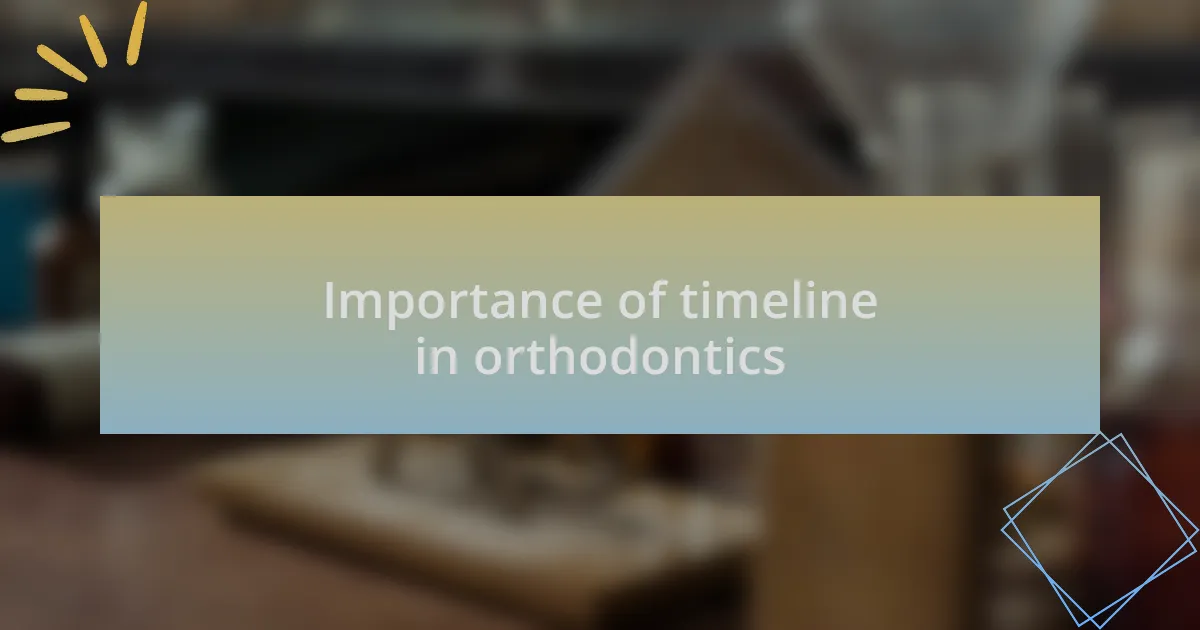
Importance of timeline in orthodontics
Having a clear timeline in orthodontics is crucial for managing expectations. I remember my orthodontist sitting down with me, laying out a detailed schedule of appointments and milestones. It helped me visualize the journey ahead, reducing any anxiety I had about the process. What if I hadn’t had that clarity? I might have felt overwhelmed and uncertain.
A well-defined timeline also encourages commitment. For instance, I recall facing a temptation to skip my aligners during a weekend getaway. However, knowing my next appointment was just around the corner motivated me to stick to my commitments. I asked myself—what’s the point of all this if I don’t follow through? Short-term sacrifices lead to long-term gains, and that was a lesson I took to heart.
Moreover, tracking my progress against the timeline gave me a sense of achievement. Each adjustment appointment felt like a mini celebration. It was immensely satisfying to see how far I had come in just a few months. It made me wonder—how many people truly grasp the importance of these small wins in their orthodontic journey? Each step forward boosts confidence and reinforces the decision to invest in a brighter, healthier smile.
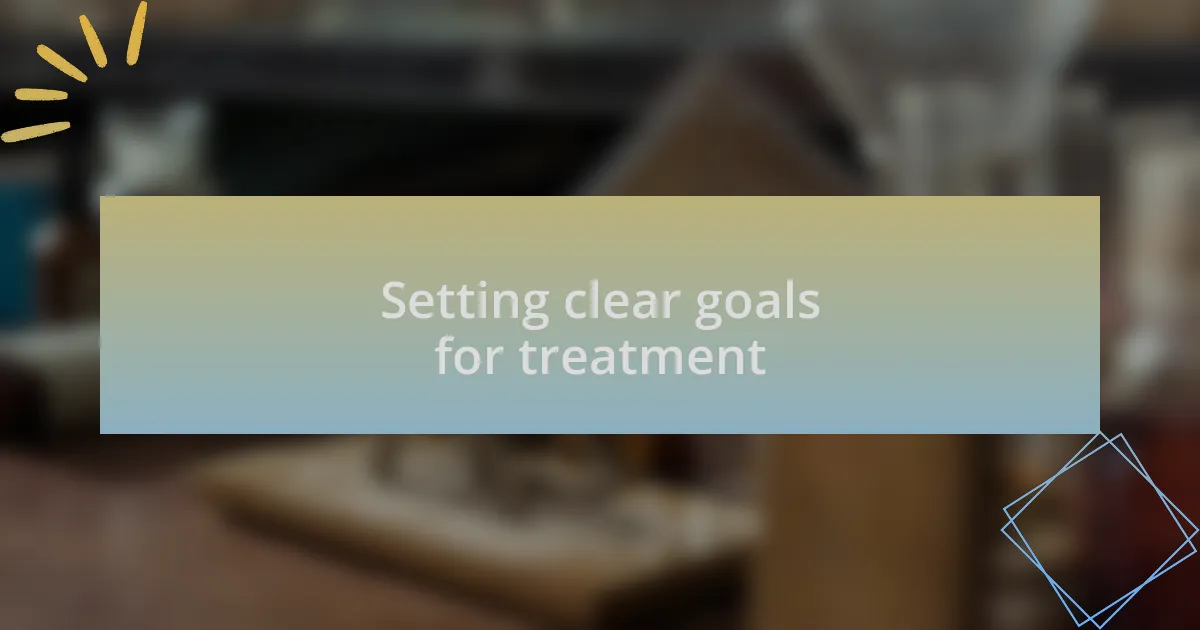
Setting clear goals for treatment
Setting clear goals for treatment is an essential step in navigating the orthodontic journey. I vividly recall when I sat down with my orthodontist to outline my objectives—straight teeth by a particular date, improved bite, and an overall boost in confidence. This moment made me realize how crucial it is to have tangible targets. Without these goals, I would have felt directionless, often asking myself, “Am I really making progress?”
When I set specific goals, like wearing my aligners for the recommended 22 hours a day, I could track my adherence closely. Each small victory, whether it was fitting into a previously tight aligner or simply sticking to my routine during a busy week, fueled my motivation. It transformed what could have felt like an endless process into a series of manageable achievements, making me think—how satisfying is it to see your hard work pay off incrementally?
Additionally, sharing these goals with my family and friends created a support network that kept me accountable. I remember my best friend checking in with me, asking, “How’s the treatment going?” Her genuine interest reminded me of my commitment, further reinforcing my goals. This network made me reflect on the importance of community in any challenging endeavor—who in your life can you count on to encourage you on this journey?
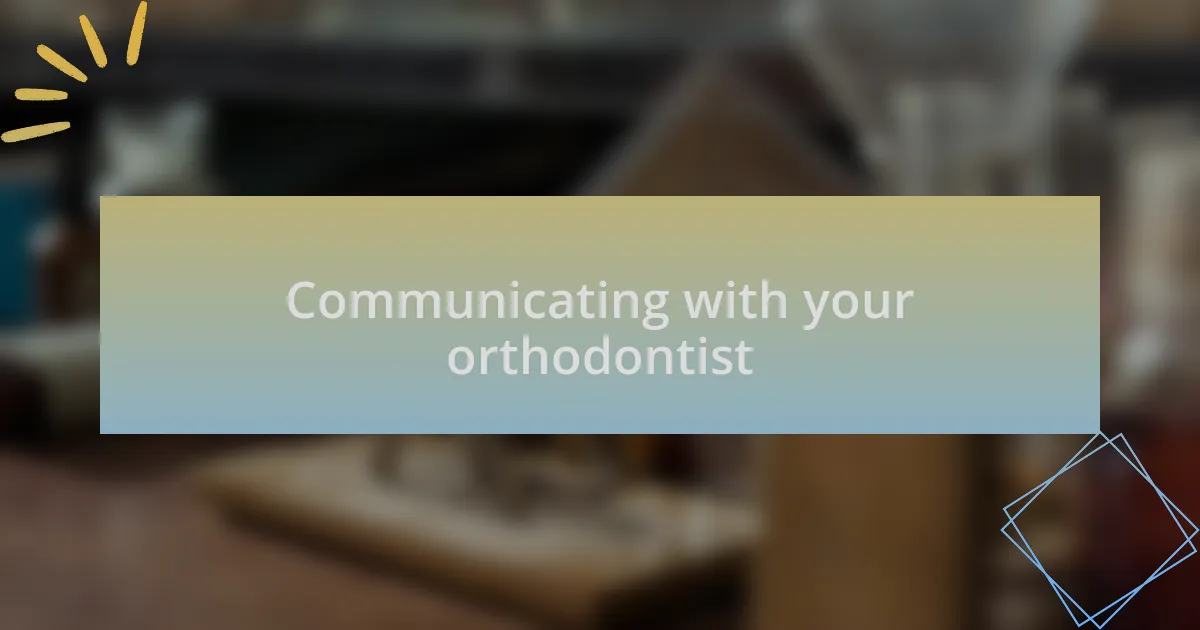
Communicating with your orthodontist
Communicating openly with your orthodontist is vital for a smooth treatment experience. I remember feeling nervous during my first appointment, unsure of what to say. But as I began to ask questions—about treatment duration, potential discomfort, and the importance of follow-ups—the conversation became more comfortable. Wouldn’t it be great if every patient felt empowered to express their concerns?
I found that sharing my experiences helped bridge any gaps in understanding. For instance, when I described the discomfort I felt after tightening my braces, my orthodontist was able to adjust my treatment plan. This back-and-forth dialogue made me feel like a partner in the process rather than just a passive recipient. Have you ever wondered how much more proactive communication could enhance your care?
Engaging with my orthodontist during visits also gave me a sense of control over my treatment path. I remember a specific moment when I brought up a concern about my progress; my orthodontist took the time to explain the reasons behind the adjustments and how they would impact my timeline. This not only calmed my nerves but also reaffirmed my trust in their expertise. How often do we realize that simply talking can lead to clarity and reassurance?
![]()
Tracking your progress effectively
Tracking your progress effectively can feel overwhelming at times, especially with all the different stages in orthodontic treatment. For me, keeping a dental journal was a game-changer. Each week, I would jot down notes about any changes I noticed or how I felt about my adjustments. This wasn’t just documentation; it became a way for me to reflect on my journey and celebrate small victories, like how my smile gradually transformed. Have you ever thought about how a simple notebook can turn your experiences into milestones?
I also discovered the effectiveness of visual tracking. Taking progress photos every few weeks helped me see the tangible changes in my teeth, reinforcing my commitment to treatment. There were moments I felt discouraged, but looking back at those photos reminded me how far I had come. Isn’t it fascinating how something as simple as a snapshot can boost motivation and remind us of our goals?
In addition, I found it really helpful to set mini-goals throughout my treatment. For instance, after noticing significant changes in the first month, I aimed to maintain my oral hygiene to ensure optimal results. Each time I reached one of these goals, I could feel my confidence grow. It made me realize how effective tracking isn’t just about monitoring physical changes; it’s also about fostering a positive mindset during a journey that can sometimes feel long and challenging.
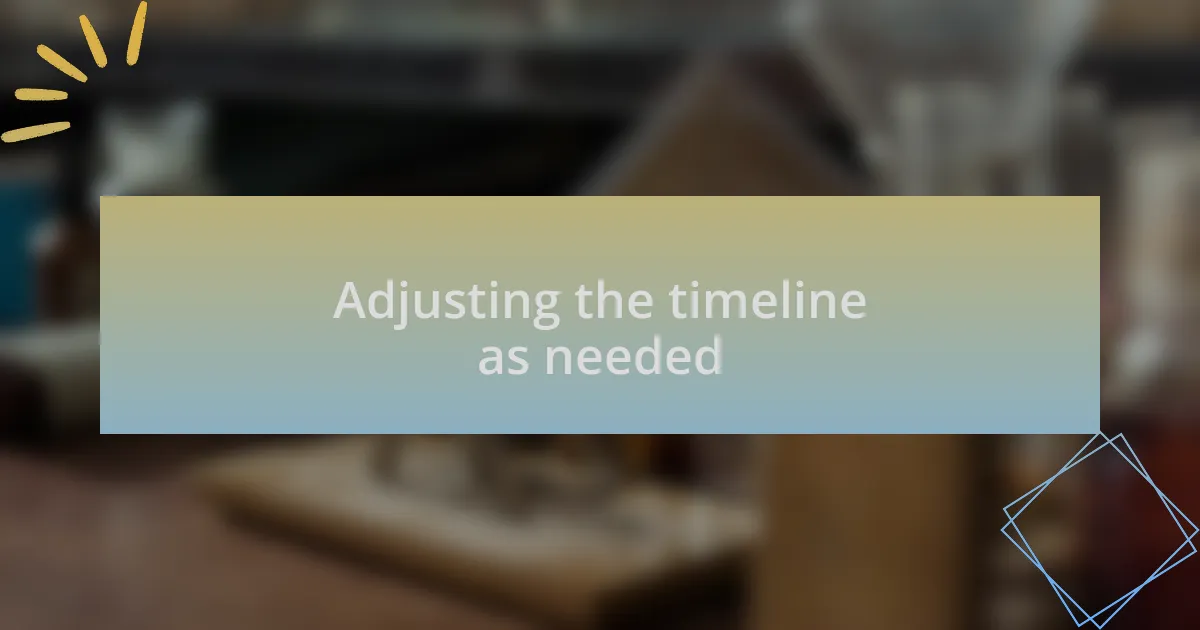
Adjusting the timeline as needed
Adjusting your orthodontic timeline can be essential to managing your treatment effectively. I found that being flexible with my expectations significantly eased the stress that came with waiting for changes. There were instances when my orthodontist suggested extending the timeline due to unanticipated shifts in my teeth. At first, I felt frustrated, but I quickly learned the importance of patience and that sometimes, the best results come from allowing a little extra time.
On one occasion, I had a particularly tough setback when an adjustment didn’t go as planned. Instead of panicking, I chose to communicate openly with my orthodontist about my concerns. This dialogue led us to identify a few modifications that improved my progress and made the timeline feel more realistic. Isn’t it uplifting to realize that a simple conversation can change the course of your treatment journey?
I’ve also realized that keeping a mental checklist of my priorities helped in adjusting timelines. When my schedule got hectic and I couldn’t dedicate enough time to my oral care, I was able to express this to my orthodontist. They often provided feedback that reassured me I could accommodate these changes without compromising my results. This adaptability has changed my perspective, reminding me that the path to a perfect smile might take unexpected turns, but that doesn’t make it less worthwhile.
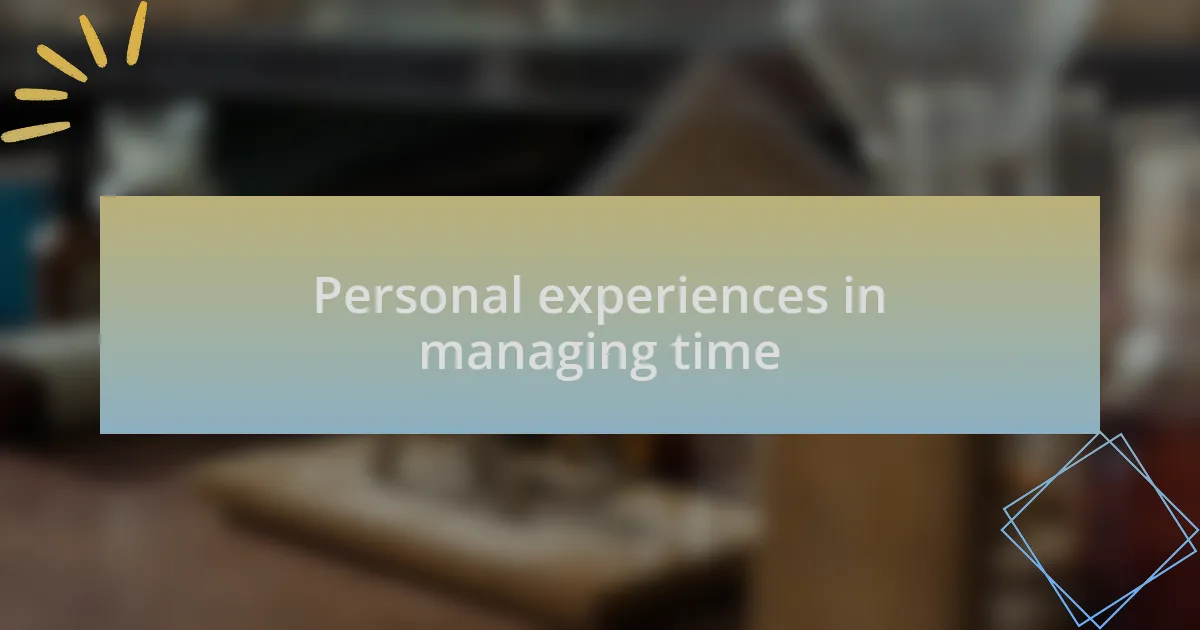
Personal experiences in managing time
Managing time throughout my orthodontic journey wasn’t always straightforward. I distinctly remember one week where my work commitments clashed with my treatment schedule. Faced with potential delays, I decided to prioritize my appointments, even if it meant reshuffling other parts of my life. That experience taught me just how vital it is to advocate for my oral health and make room for what truly matters.
There were days when I felt overwhelmed by the sheer number of adjustments I had to fit into my routine. I vividly recall a particularly challenging month where social events kept piling up, and I struggled to maintain a consistent oral care regimen. Instead of feeling defeated, I scheduled “intentional check-in” days for myself, reminding me to focus solely on my orthodontic needs. Have you ever had to do a reset like that? It was refreshing to carve out that time, allowing me to reconnect with my goals and feel in control again.
Ultimately, I discovered that small victories in time management really added up. For instance, dedicating just ten minutes each day to track my progress and treatment milestones became a game-changer. It transformed how I viewed my journey, allowing me to celebrate the little achievements, which kept my motivation high. Isn’t it fascinating how those small moments can provide such a powerful boost when navigating a lengthy process?